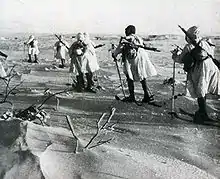| Japanese Twenty-Seventh Army | |
|---|---|
 Japanese ski troops in the Chishima Islands | |
| Active | March 16, 1944 – February 1, 1945 |
| Country | Empire of Japan |
| Branch | Imperial Japanese Army |
| Type | Infantry |
| Role | Corps |
| Garrison/HQ | Etorofu |
| Nickname(s) | Hokubu (北部, Northern) |
| Engagements | Soviet invasion of Manchuria |
The Japanese 27th Army (第27軍, Dai-nijyūnana gun) was an army of the Imperial Japanese Army during the final days of World War II.
History
The Japanese 27th Army was formed on March 16, 1944, as part of the last desperate defense effort by the Empire of Japan to deter possible landings of Allied forces in the northern Chishima Islands territories from northeastern Hokkaidō to Kamchatka during Operation Downfall. It was headquartered on Etorofu.
The Japanese 27th Army consisted mostly of poorly trained reservists, conscripted students and home guard militia. It was disbanded on February 1, 1945, and its units were incorporated directly into the Japanese 5th Area Army
List of Commanders
| Name | From | To | |
|---|---|---|---|
| Commanding officer | Lieutenant General Shozo Terakura | 10 March 1944 | 1 February 1945 |
| Chief of Staff | Major General Keiji Suzuki | 10 March 1944 | 1 February 1945 |
See also
References
- Drea, Edward J. (1998). "Japanese Preparations for the Defense of the Homeland & Intelligence Forecasting for the Invasion of Japan". In the Service of the Emperor: Essays on the Imperial Japanese Army. University of Nebraska Press. ISBN 0-8032-1708-0.
- Frank, Richard B (1999). Downfall: The End of the Imperial Japanese Empire. New York: Random House. ISBN 0-679-41424-X.
- Jowett, Bernard (1999). The Japanese Army 1931-45 (Volume 2, 1942-45). Osprey Publishing. ISBN 1-84176-354-3.
- Madej, Victor (1981). Japanese Armed Forces Order of Battle, 1937-1945. Game Publishing Company. ASIN: B000L4CYWW.
- Marston, Daniel (2005). The Pacific War Companion: From Pearl Harbor to Hiroshima. Osprey Publishing. ISBN 1-84176-882-0.
- Skates, John Ray (1994). The Invasion of Japan: Alternative to the Bomb Downfall. New York: University of South Carolina Press. ISBN 0-87249-972-3.
External links
- Wendel, Marcus. "Axis History Factbook". Japanese Twenty Seventh Army.
This article is issued from Wikipedia. The text is licensed under Creative Commons - Attribution - Sharealike. Additional terms may apply for the media files.